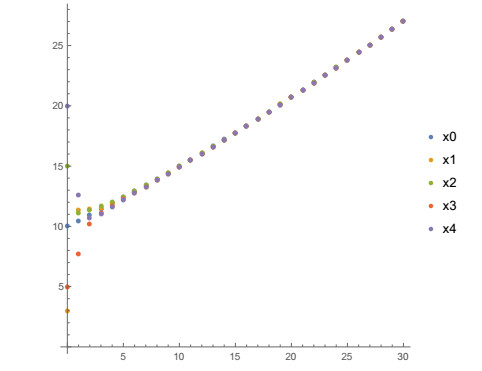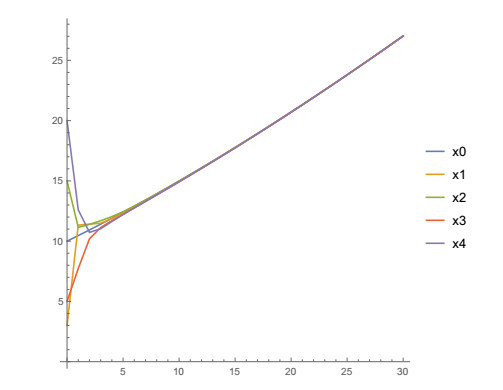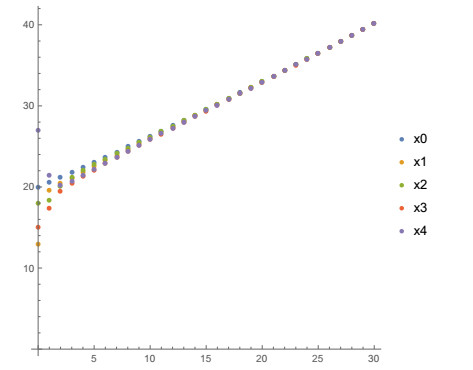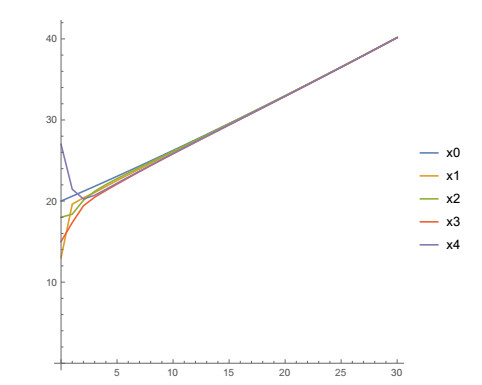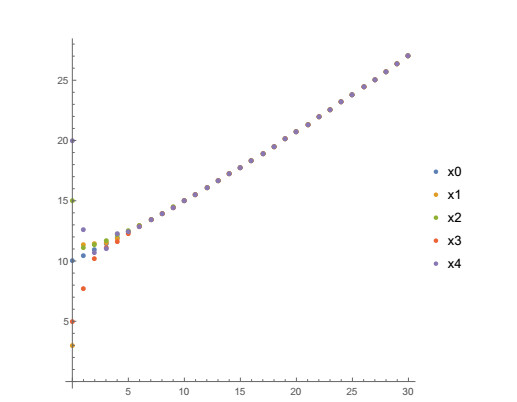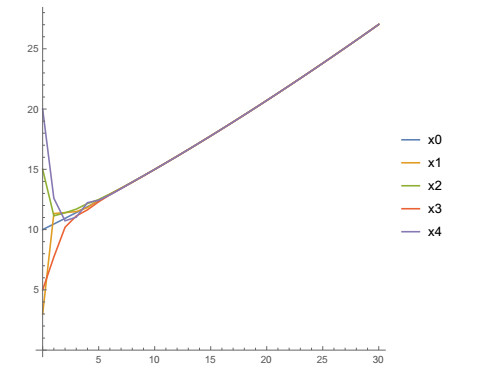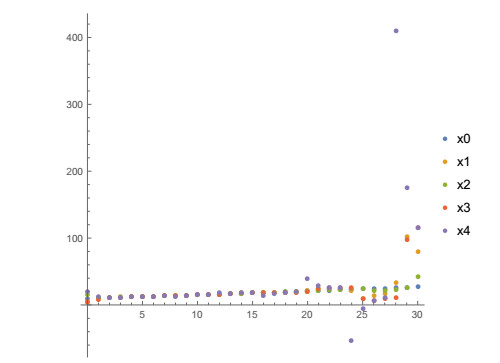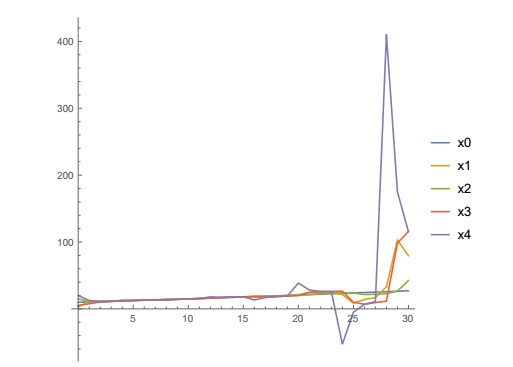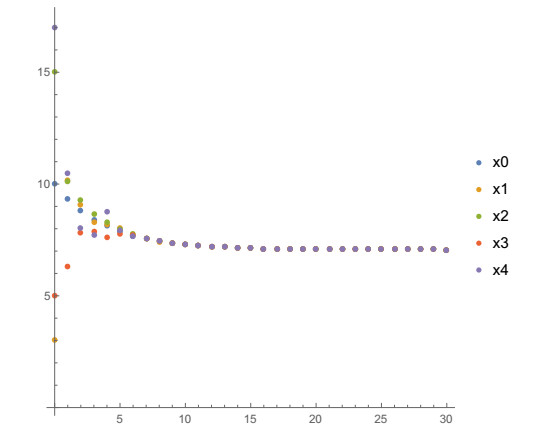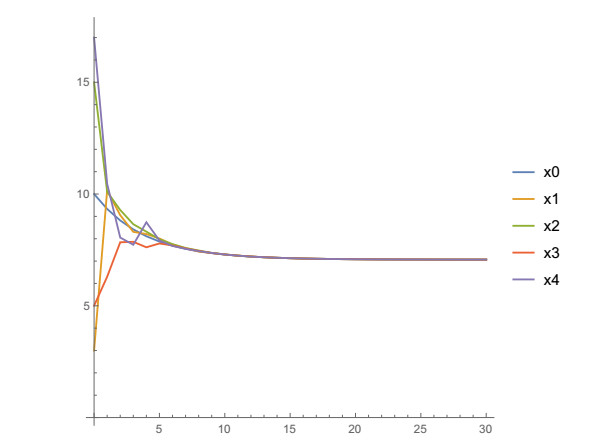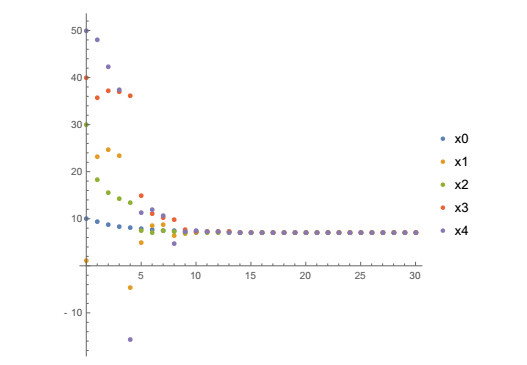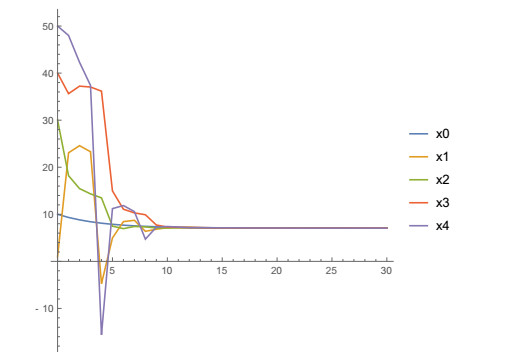A leader-following consensus of discrete-time multi-agent systems with nonlinear intrinsic dynamics and impulses is investigated. We propose and prove conditions ensuring a leader-following consensus. Numerical examples are given to illustrate effectiveness of the obtained results. Also, the necessity and sufficiency of the obtained conditions are shown.
1.
Introduction
Multi-attribute group decision-making (MAGDM) is a crucial component of contemporary decision theory, widely applied in various fields such as management, science and technology and the economy. Traditional MAGDM methods require decision data to be provided in the form of precise real numbers. However, due to the complex social environment, increasing uncertainty and the subjective nature of human thinking, solving practical decision problems using traditional MAGDM methods has become increasingly challenging. In order to solve this issue, scholars put forward fuzzy numbers as a measure of attributes. In 1965, Zadeh [1] introduced fuzzy sets (FS) and the utilization of membership degrees to resolve ambiguity in decision-making problems. Then, Atanassov [2] extended fuzzy sets to intuitionistic fuzzy sets (IFS), considering the degree of non-membership and hesitation. Yager [3] proposed the Pythagorean fuzzy set (PFS), which extends the range of membership and non-membership degrees to the sum of their squares not exceeding 1. Subsequently, Yager [4] proposed orthopair fuzzy sets (q-ROFS) as a new tool to deal with uncertainty on the basis of IFS and PFS, and extended membership and non-membership degrees to the space range where the sum of q powers does not exceed 1. Alrasheedi et al. [5] proposed q-rung orthopair fuzzy aggregation operators based on soft maximum, and applied them to material selection. Considering that the lack of available information prevents experts from quantifiable their judgments with an exact value when dealing with real life decision problems, Joshi et al. [6] proposed the concept of interval-valued q-rung orthopair fuzzy sets (q-RIVOFS), enabling decision makers to express their satisfaction and dissatisfaction with a set of alternatives in the form of intervals. Many scholars have done research on this issue. Wang et al. [7] examined the symmetry between attribute information and 4 distinct types of information aggregation operators applied to q-rung interval-valued orthopair fuzzy information in multi-attribute group decision-making. Zhang et al. [8] considered the interaction between decision makers and attributes, extending hesitant fuzzy sets to the q-rung interval-valued orthopair fuzzy environment. However, due to the complexity of decision environment and the uncertainty of decision information, it is necessary to further expand the application range of fuzzy sets, providing decision-makers with a more relaxed decision-making environment.
In multi-attribute group decision making, the rational determination of attribute weights is a key problem. Due to the difficulty of accurately defining attribute weights in practical problems, various methods have been proposed by scholars to address this challenge. At present, there are three main methods for determining attribute weights: subjective weighting, objective weighting and combined weighting. The single subjective and objective methods often have subjective preferences or inconsistent objective laws, whereas the combined weighting method can integrate the advantages of both methods and mitigate their limitations. Common subjective weighting methods include the Best-Worst Method (BWM), Linear Barycentric Weighting Approach (LBWA), Full Consistency Method (FUCOM), ANP and so on. The BWM method [9,10,11] is relatively easy to understand and implement, but it may oversimplify complex decision scenarios, and only consider the best and worst attributes, possibly ignoring other crucial factors. The LBWA method [12,13] is simple, intuitive and easy to understand, but it heavily relies on attribute weights and ignores possible relationships and mutual influences among attributes. The FUCOM method [14,15] is a fuzzy compromise method that enables decision makers to better weigh different decision criteria in complex situations, but its calculation is relatively complex and easily affected by parameters, and the interpretation of the results may be relatively unintuitive. The ANP method [16,17] can be used to deal with complex decision-making environments involving the interdependence and feedback between criteria and alternatives. It enables decision-makers to obtain a clear understanding and analysis of the interdependencies among criteria, facilitating a more realistic and detailed decision-making process. It also helps overcome the uncertainty of outcomes caused by changes in personal preferences to some extent. The Entropy method [18,19,20] is a commonly used objective weighting method. It calculates the relative weight of each criterion based on the entropy value of each criterion, avoiding the problem of subjective weighting. This method allows for a more comprehensive assessment of the importance of each criterion, taking into account the amount of information it contains. Therefore, in order to consider the interaction between decision-makers and the relationship between attributes, the ANP method and entropy method are used in this paper to obtain subjective and objective weights, respectively. Additionally, considering the influence of subjective and objective weights on the combination weights, the deviation degree and dispersion degree of the subjective and objective weights are taken as objective functions to build a weight optimization model, and the optimal solution of the combination weights is iteratively solved by genetic algorithm. This approach aims to obtain more reasonable attribute weights by exploring the solution space through repeated selection, crossover, and mutation operations, gradually converging to the optimal or near-optimal solution.
In order to better solve multi-attribute group decision problems, scholars have proposed various decision methods, such as VIKOR, Measurement of Alternatives and Ranking according to Compromise Solution (MARCOS), Multi-Attributive Border Approximation Area Comparison (MABAC), ELECTRE and so on. The VIKOR method [21,22,23] is a multi-criteria decision-making method that is relatively easy to understand and apply, allowing decision makers to combine their preferences and weights based on different criteria. However, it may not always provide a clear explanation of how to reach a compromise solution, which can hinder understanding of the decision-making process. The MARCOS method [24,25,26] is a decision-making method and software developed by Thomas L. Saaty. It provides a structured approach to decision-making, helping to organize and analyze decision-making factors effectively. However, it requires a comprehensive understanding of the method and its implementation, and obtaining accurate and reliable data can be challenging. The MABAC method [27,28] is a multi-criteria decision-making method for evaluating and ranking alternatives based on multiple criteria. It utilizes a geometric representation called the boundary approximation region, which facilitates visual comparison of alternatives and enhances understanding and communication in the decision-making process. However, it involves sequencing the boundary values and calculating the area of the boundary region, resulting in high computational complexity when dealing with large decision-making problems. Therefore, it may not be suitable for complex decision problems. The ELECTRE method, introduced by Almeida [29] in 2005, is a decision-making method that constructs a series of preference relationships and evaluates candidate solutions to determine the optimal solution. It can handle multiple criteria simultaneously, process large amounts of information and decision data, allow qualitative descriptions or ranking comparisons to express criteria relationships and provide clear decision results. It helps decision-makers understand and explain the final decision choices. Compared to VIKOR, MARCOS, and MABAC, the ELECTRE method has several advantages. Scholars have conducted research on the theory and application of the ELECTRE method. Chen [30] utilized a multi-criteria evaluation and selection approach using interval-valued intuitionistic fuzzy ELECTRE to analyze multi-criteria choices. Jagtap and Karande [31] proposed an improved Simos and AHP weight calculation method to improve the accuracy and consistency of weight calculation, and they applied it to the ELECTRE-I method based on M-polarity fuzzy sets to solve the selection problem of non-traditional machining processes. On the basis of existing research, it is evident that the ELECTRE method is an effective way to solve decision problems. Therefore, it is necessary to enhance and extend the ELECTRE method to a new fuzzy environment and propose a new multi-attribute group decision making method.
To sum up, extensive research has been conducted on fuzzy sets and weights both domestically and internationally, resulting in significant achievements. Scholars have made important contributions to decision-making methods. However, further expansion of the desirable range of attribute values in existing studies is warranted. Additionally, there is a lack of research on decision-making situations that considers the interaction between decision-makers and the relationships between attributes. Exploring methods to enhance existing decision-making approaches is also a worthwhile area of study. Therefore, this paper proposes a multi-attribute group decision-making algorithm based on weight optimization and an improved ELECTRE method in the context of (p, q)-rung interval-valued orthopair fuzzy environment. The remainder of the paper is structured as follows. In Section 2, we introduce relevant definitions that will be utilized throughout this paper. In Section 3, the (p, q)-rung interval-valued orthopair fuzzy set is defined, along with its relevant concepts. In Section 4, we consider the mutual influence between decision-makers and the interrelationships between attributes and develop a weight optimization model. Based on the weight optimization model and the definition of the (p, q)-rung interval-valued orthopair fuzzy set, an improved (p, q)-rung interval-valued orthopair fuzzy ELECTRE method is presented. In Section 5, the efficacy and practicability of the proposed algorithm are validated via parametric analysis and contrastive analysis with related studies using the selection of investment companies as an illustration. In Section 6, we conclude this paper with a summary.
2.
Preliminaries
This section provides an introduction to the fundamental concepts of fuzzy sets and the operational rules of fuzzy numbers.
Definition 1. [2] Let Ω serve as the domain of discussion. An intuitionistic fuzzy set on Ω is denoted by I={<a,fI(a),hI(a)>|a∈Ω}, where fI:Ω→[0,1] and hI:Ω→[0,1] denote the membership and non-membership degrees, respectively, of an element a in Ω and satisfy the condition 0⩽fI(a)+hI(a)⩽1. The hesitation degree of element a belonging to set I is denoted by
Definition 2. [32] Let Ω serve as the domain of discussion. A Pythagorean fuzzy set on Ω is denoted by R={<a,fR(a),hR(a)>|a∈Ω}, where fR:Ω→[0,1] and hR:Ω→[0,1] denote the membership and non-membership degrees, respectively, of an element a in Ω and satisfy the condition 0⩽(fR(a))2+(hR(a))2⩽1. The hesitation degree of element a belonging to set R is denoted by
Definition 3. [4] Let Ω serve as the domain of discussion. A q-rung orthopair fuzzy set on Ω is denoted by Q={<a,fQ(a),hQ(a)>|a∈Ω}, where fQ:Ω→[0,1] and hQ:Ω→[0,1] denote the membership and non-membership degrees, respectively, of an element a in Ω and satisfy the condition 0⩽(fQ(a))q+(hQ(a))q⩽1, where q is a positive integer. The hesitation degree of element a belonging to set Q is denoted by
and for convenience, Q=(fQ,hQ) are called q-rung orthopair fuzzy numbers.
Definition 4. [33] Let Ω serve as the domain of discussion. A Fermatean fuzzy set on Ω is denoted by F={<a,fF(a),hF(a)>|a∈Ω}, where fF:Ω→[0,1] and hF:Ω→[0,1] denote the membership and non-membership degrees, respectively, of an element a in Ω and satisfy 0⩽(fF(a))3+(hF(a))3⩽1. The hesitation degree of element a belonging to set F is defined as
Definition 5. [6] Let Ω serve as the domain of discussion. A q-rung interval-valued orthopair fuzzy set on Ω is denoted by ˜Q={<a,f˜Q(a),h˜Q(a)>|a∈Ω}, where f˜Q:Ω→[0,1] and h˜Q:Ω→[0,1] denote the membership and non-membership degrees, respectively, of an element a in Ω, where f˜Q(a)=[fL˜Q(a),fR˜Q(a)]⊂[0,1] and h˜Q(a)=[hL˜Q(a),hR˜Q(a)]⊂[0,1], and for any a∈Ω, fq˜Q(a)⩾0, hq˜Q(a)⩾0, and for natural numbers q, we have 0⩽(fR˜Q(a))q+(hR˜Q(a))q⩽1. The hesitation degree that an element a belongs to set ˜Q is defined as
and for convenience, ˜α=([fL˜Q,fR˜Q],[hL˜Q,hR˜Q]) is referred to as a q-rung interval-valued orthopair fuzzy number. Let Δ represent the set of all q-rung interval-valued orthopair fuzzy numbers.
Given two q-rung interval-valued orthopair fuzzy numbers, denoted by ˜α=([fL˜α,fR˜α],[hL˜α,hR˜α])∈Δ and ˜β=([fL˜β,fR˜β],[hL˜β,hR˜β])∈Δ, their operational rules can be represented as below [4]:
(1)˜α⊕˜β=([((fL˜α)q+(hL˜β)q−(fL˜α)q(hL˜β)q)1/1qq,((fR˜α)q+(hR˜β)q−(fR˜α)q(hR˜β)q)1/1qq],[fL˜αhL˜β,fR˜αhR˜β]);
(2)˜α⊗˜β=([fL˜αhL˜β,fR˜αhR˜β],[((fL˜α)q+(hL˜β)q−(fL˜α)q(hL˜β)q)1/1qq,((fR˜α)q+(hR˜β)q−(fR˜α)q(hR˜β)q)1/1qq]);
(3)λ˜α=([(1−(1−(fL˜α)q)λ)1/1qq,(1−(1−(fR˜α)q)λ)1/1qq],[(hL˜α)λ,(hR˜α)λ]),λ>0;
(4)(˜α)λ=([(fL˜α)λ,(fR˜α)λ],[(1−(1−(hL˜α)q)λ)1/1qq,(1−(1−(hR˜α)q)λ)1/1qq]),λ>0;
(5)˜αc=([hL˜α,hR˜α],[fL˜α,fR˜α]).
Example 1 is used to illustrate the limitations of the existing q-rung interval-valued orthopair fuzzy set.
Example 1. Suppose that ([0.71, 0.8], [0.61, 0.8]) is a q-rung interval-valued orthopair fuzzy number, where q is a positive real number. When applying definition 5, it is found that 0.83+0.83 > 1. This calculation reveals that the fuzzy number does not meet the value range defined by the q-rung interval-valued orthopair fuzzy set. This discrepancy indicates the need for expanding the desirable range of attribute values to effectively address real-world situations.
3.
(p, q)-rung interval-valued orthopair fuzzy set
Example 1 highlights the inadequacy of the existing definition and the limited desirable range of attribute values for q-rung interval-valued orthopair fuzzy sets. In the following, the definition of a (p, q)-rung interval-valued orthopair fuzzy set ((p, q)-RIVOFS) is proposed to make up for the deficiency, and its desirable range is further extended, which can deal with the uncertainty of multi-attribute group decision more effectively than a q-rung interval-valued orthopair fuzzy set.
Definition 6. Let Ω serve as the domain of discussion. A (p, q)-rung interval-valued orthopair fuzzy set on Ω is denoted by ℜ={<x,fℜ(x),hℜ(x)>|x∈Ω}, where fℜ(x)=[fLℜ(x),fRℜ(x)] and hℜ(x)=[hLℜ(x),hRℜ(x)] are interval numbers belonging to the interval [0, 1], denoting the membership and non-membership degrees, respectively, of an element x in Ω. For any x∈Ω, and for natural numbers p and q, we have 0⩽(fRℜ(x))p+(hRℜ(x))q⩽1. The hesitation degree that an element x belongs to set ℜ is defined as
For convenience, α=([fLα,fRα],[hLα,hRα]) is referred to as a (p, q)-rung interval-valued orthopair fuzzy number.
If α=([fLα,fRα],[hLα,hRα]) and β=([fLβ,fRβ],[hLβ,hRβ]) are two (p, q)-rung interval-valued orthopair fuzzy numbers, then the following arithmetic rules hold:
(1)α⊕β=([k√(fLα)p+(hLβ)q−(fLα)p(hLβ)q,k√(fRα)p+(hRβ)q−(fRα)p(hRβ)q],[fLαhLβ,fRαhRβ]);
(2)α⊗β=([fLαhLβ,fRαhRβ],[k√(fLα)p+(hLβ)q−(fLα)p(hLβ)q,k√(fRα)p+(hRβ)q−(fRα)p(hRβ)q]);
(3)λα=([(1−(1−(fLα)p)λ)1/1kk,(1−(1−(fRα)p)λ)1/1kk],[(hLα)λ,(hRα)λ]),λ>0;
(4)αλ=([(fLα)λ,(fRα)λ],[(1−(1−(hLα)q)λ)1/1kk,(1−(1−(hRα)q)λ)1/1kk]),λ>0;
(5)αc=([hLα,hRα],[fLα,fRα]).
To illustrate the necessity of extending the desirable range of attribute values and the validity of definition 6, we provide an illustrative example.
Example 2. Suppose that ([0.71, 0.8], [0.61, 0.8]) is the attribute value of an element on set ℜ. When computed using q-RIVOFS, it is found that 0.83+0.83 > 1. However, when computed using (p, q)-RIVOFS, it yields 0.83+0.84 < 1. This comparison shows that (p, q)-RIVOFS can deal with a wider range of attribute values than q-RIVOFS.
It can be seen from example 2 that the value of this attribute is not satisfied with the desirable spatial range of the q-rung interval-valued orthopair fuzzy set. Consequently, this case cannot be adequately addressed by the q-RIVOFS. However, the (p, q)-rung interval-valued orthopair fuzzy set can successfully capture this set of attribute values. Therefore, it is apparent that incorporating the parameter p into the (p, q)-rung interval-valued orthopair fuzzy set enhances its effectiveness in dealing with the uncertainty of multi-attribute group decision problems encountered in real-life scenarios.
The related properties of (p, q)-rung interval-valued orthopair fuzzy sets are described below.
3.1. Ranking of (p, q)-rung interval-valued orthopair fuzzy sets
Their scoring functions and precision functions are constructed to compare the magnitudes of two (p, q)-rung interval-valued orthopair fuzzy numbers.
Definition 7. For any (p, q)-rung interval-valued orthopair fuzzy number α=([fLα,fRα],[hLα,hRα]), the function (1) is called the score function of α.
The function (2) is called the precision function of α.
Given α1=([fLα1,fRα1],[hLα1,hRα1]), α2=([fLα2,fRα2],[hLα2,hRα2]), the following conditions hold:
(1) If S(α1)>S(α2), then α1 is said to be greater than α2, as indicated by α1>α2.
(2) If S(α1)=S(α2), then α1 is said to be equal to α2 when H(α1)=H(α2); otherwise, α1 is said to be less than α2 when H(α1)>H(α2).
3.2. Weighted average operator for (p, q)-rung interval-valued orthopair fuzzy sets
Definition 8. Let αj=([fLαj,fRαj],[hLαj,hRαj]) be a (p, q)-rung interval-valued orthopair fuzzy number, ω=(ω1,ω2,...,ωn)T be a vector of weights for αj, ωj∈[0,1] and ∑nj=1ωj=1. If
(p, q)-RIVOFWA is then referred to as the (p, q)-rung interval-valued orthopair fuzzy weighted average operator.
Theorem 1. Let αj=([fLαj,fRαj],[hLαj,hRαj]) be a (p, q)-rung interval-valued orthopair fuzzy number, ω=(ω1,ω2,...,ωn)T be a vector of weights for αj, ωj∈[0,1] and ∑nj=1ωj=1. Then,
Proof. Theorem 1 is demonstrated via mathematical induction.
When n = 1, the theorem is visibly correct.
When n = 2, we have
Assuming the theorem holds when n = k, we have
When n = k+1, we have
Therefore, when n = k+1, the equation holds, and hence it holds for any value of n. The proof is complete.
The following are the relevant properties satisfied by the (p, q)-RIVOFWA operator:
Theorem 2. (Boundedness) Let αj=([fLαj,fRαj],[hLαj,hRαj]), j = 1, 2, …, n, be (p, q)-rung interval-valued orthopair fuzzy numbers, where α−=min(α1,α2,...,αn) and α+=max(α1,α2,...,αn). Then
Theorem 3. (Idempotence) Let αj=([fLαj,fRαj],[hLαj,hRαj]), j = 1, 2, …, n, be (p, q)-rung interval-valued orthopair fuzzy numbers. If for any αj, αj=α and ω=(1n,1n,...,1n)T, then
Theorem 4. (Monotonicity) Let αj=([fLαj,fRαj],[hLαj,hRαj]) and α′j=([fLα′j,fRα′j],[hLα′j,hRα′j]), j = 1, 2, …, n, be (p, q)-rung interval-valued orthopair fuzzy numbers such that ∀j=1,2,...,n, αj⩽α′j, [fLα′j,fRα′j]⩾[fLαj,fRαj] and [hLα′j,hRα′j]⩽[hLαj,hRαj]. Then,
3.3. Entropy measure of (p, q)-rung interval-valued orthopair fuzzy sets
In the context of fuzzy set theory and multi-attribute decision-making issues, entropy is a crucial measure of information that may be utilized to quantify the degree of fuzziness of attributes and establish attribute weights.
Definition 9. A real function E: (p, q)-RIVOFS(X)→[0, 1] is referred to as the entropy of a (p, q)-rung interval-valued orthopair fuzzy set, if it satisfies the following criteria:
(1) E(ℜ)=0 if and only if the (p, q)-rung interval-valued orthopair fuzzy set is a crisp set.
(2) E(ℜ)=0 if and only if for all x∈X, fℜ=hℜ=[0,0].
(3) When fLℜ2(x)⩽hLℜ2(x) and fRℜ2(x)⩽hRℜ2(x), there is fLℜ1(x)⩽fLℜ2(x), fRℜ1(x)⩽fRℜ2(x), hLℜ1(x)⩾hLℜ2(x), hRℜ1(x)⩾hRℜ2(x); when fLℜ2(x)⩾hLℜ2(x) and fRℜ2(x)⩾hRℜ2(x), there is fLℜ1(x)⩾fLℜ2(x), fRℜ1(x)⩾fRℜ2(x), hLℜ1(x)⩽hLℜ2(x), hRℜ1(x)⩽hRℜ2(x). Then, E(ℜ1)⩽E(ℜ2) is established.
(4) E(ℜ)=E(ℜC).
Below is a formula for calculating the entropy of (p, q)-rung interval-valued orthopair fuzzy sets that satisfies the four constraints mentioned above:
Definition 10. Let ℜ serve as a (p, q)-rung interval-valued orthopair fuzzy set on a fixed set Ω. Then, the formula
is a (p, q)-rung interval-valued orthopair fuzzy entropy formula that satisfies the axiomatic definition 9.
Proof. (1) When ℜ is a definite set, that is, fℜ=[1,1], hℜ=[0,0] or fℜ=[0,0], hℜ=[1,1], E(ℜ)=12(cosπ2−cosπ2+2−1−1)=0. Conversely, if E(ℜ)=0, we can conclude that either fℜ=[1,1] or fℜ=[0,0], which implies that VB is a definite set.
(2) When fℜ=hℜ=[0,0], E(ℜ)=12(cos0−cos0+2−0−0)=1.
(3) Let
be a function defined as above, where x1,y1,x2,y2∈[0,1]. We will compute the partial derivatives of f(x1,y1,x2,y2) with respect to x1, y1, x2, y2:
When x1⩽x2, y1⩽y2, ∂f(x1,y1,x2,y2)∂x1⩾0, ∂f(x1,y1,x2,y2)∂x2⩽0, ∂f(x1,y1,x2,y2)∂y1⩾0 and ∂f(x1,y1,x2,y2)∂y2⩽0, the function f(x1,y1,x2,y2) is monotonically increasing with respect to x1, y1, and monotonically decreasing with respect to x2, y2. Therefore, when fLℜ2(x)⩽hLℜ2(x) and fRℜ2(x)⩽hRℜ2(x), we have fLℜ1(x)⩽fLℜ2(x), fRℜ1(x)⩽fRℜ2(x), hLℜ1(x)⩾hLℜ2(x), hRℜ1(x)⩾hRℜ2(x). Then, E(ℜ1)⩽E(ℜ2).
Similarly, when fLℜ2(x)⩾hLℜ2(x), fRℜ2(x)⩾hRℜ2(x), we have fLℜ1(x)⩾fLℜ2(x), fRℜ1(x)⩾fRℜ2(x), hLℜ1(x)⩽hLℜ2(x), hRℜ1(x)⩽hRℜ2(x).
(4) The proof of (4) is obvious.
3.4. The distance measure of (p, q)-rung interval-valued orthopair fuzzy sets
An essential tool in fuzzy set theory and a common application in decision-making problems is the distance measure between (p, q)-rung interval-valued orthopair fuzzy vectors.
Definition 11. Let a=([fLa,fRa],[hLa,hRa]), b=([fLb,fRb],[hLb,hRb]) and c=([fLc,fRc],[hLc,hRc]) be three (p, q)-rung interval-valued orthopair fuzzy numbers. A function d is considered to be a (p, q)-rung interval-valued orthopair fuzzy distance measure between a and b if it satisfies the conditions outlined below:
(1) d(a,b)⩾0;
(2) d(a,b)=d(b,a);
(3) d(a,b)=0⇔a=b;
(4) If a⩽b⩽c, then d(a,c)+d(c,b)⩾d(a,b).
Based on four conditions, this definition establishes a (p, q)-rung interval-valued fuzzy orthopair fuzzy distance measure between a and b, referred to as d(a, b). These conditions ensure that the distance measure satisfies basic properties such as non-negativity, symmetry and the triangle inequality.
Among the various distance measures, Hamming distance and Euclidean distance are the most commonly used.
Definition 12. Given two (p, q)-rung interval-valued orthopair fuzzy numbers a=([fLa,fRa],[hLa,hRa]) and b=([fLb,fRb],[hLb,hRb]), we have the following.
(1) (p, q)-rung interval-valued orthopair fuzzy Hamming distance dH(a,b):
(2) (p, q)-rung interval-valued orthopair fuzzy Euclidean distance dE(a,b):
These distance measures provide a way to quantify the similarity or dissimilarity between (p, q)-rung interval-valued orthopair fuzzy numbers in decision-making questions.
The purpose of this study is to demonstrate that the two distance measures presented satisfy the conditions of a distance measure as defined in Definition 12.
The Hamming distance measure will be used as an example.
Proof. (1) To prove the above, we will begin by showing that condition (1) is evident. The Hamming distance is defined as the number of elements that differ in two vectors in the same position. Therefore, the Hamming distance is always a non-negative value.
(2)
From the nature of absolute value, dH(a,b)=dH(b,a). Therefore, condition (2) is proved.
(3)
Therefore, condition (3) is proved.
(4)
Therefore, condition (4) is proved.
By applying the same logic, it can be demonstrated that the Euclidean distance meets the criteria for a distance measure as specified in Definition 12.
Definition 13. Assume α=(α1,α2,...,αn)T and β=(β1,β2,...,βn)T be (p, q)-rung interval-valued orthopair fuzzy vectors, where αi=([fLαi,fRαi],[hLαi,hRαi]) and βi=([fLβi,fRβi],[hLβi,hRβi]), i = 1, 2, …, n. The distance between α and β is thus specified as
The term 'standard Hamming distance' for (p, q)-rung interval-valued orthopair fuzzy vectors refers to this distance.
Theorem 5. Let α, β and γ be three (p, q)-rung interval-valued orthopair fuzzy vectors, and let dH(α,β), dH(β,γ) and dH(α,γ) denote the (p, q)-rung interval-valued orthopair fuzzy standard Hamming distances between α and β, β and γ and α and γ, respectively. Then,
(1) dH(α,β)=dH(β,α), which implies that the distance measure is symmetric.
(2) If α⩽γ⩽β, then dH(α,β)+dH(β,γ)⩾dH(α,γ), which implies that the distance measure satisfies the triangle inequality.
(3) dH(α,β)⩾0, which implies that the distance measure is non-negative and zero only when comparing identical vectors.
(4) If dH(α,β)=0, then α=β holds, indicating that the distance measure satisfies the identity of indiscernibles.
These characteristics demonstrate that the (p, q)-rung interval-valued orthopair fuzzy standard Hamming distance is a valid distance measure for comparing (p, q)-rung interval-valued orthopair fuzzy vectors.
4.
(p, q)-rung interval-valued orthopair fuzzy multiple attribute group decision-making algorithm based on weighted optimization
This section primarily introduces the steps of a fuzzy multi-attribute group decision-making algorithm on the basis of weighted optimization and (p, q)-rung interval-valued orthopair fuzzy sets. First, each decision expert expresses the ambiguous evaluation information of alternative solutions under distinct attributes. Second, the subjective and objective weights are then determined using network analysis and entropy methods, and a model for weight optimization is developed. The (p, q)-RIVOFWA operator is then employed for transforming a (p, q)-rung interval-valued orthopair fuzzy decision information matrix into a comprehensive decision matrix. Finally, the improved ELECTRE method is used to calculate the total advantage value, total disadvantage value and total evaluation value of each solution. In order to determine the best option, the solutions are ranked based on the total evaluation value.
Let A={A1,A2,...,Am} be the set of alternative solutions, M={M1,M2,...,Mn} be the set of attributes and there be t decision experts. Let c(k)ij denote the k-th expert's assessment value for the alternative solution Ai in attribute Mj, where c(k)ij=(fij(x)(k),hij(x)(k)) is a (p, q)-rung interval-valued orthopair fuzzy number. Let the weight vector for each index attribute be ω={ω1,ω2,…,ωn}, where 0≤ωj≤1 and ∑nj=1ωj=1. The following are the decision-making stages of the algorithm proposed in this paper:
Step 1: Constructing the (p, q)-rung interval-valued orthopair fuzzy decision matrix.
The fuzzy evaluations of the candidate alternatives by distinct decision makers under different attributes are represented using (p, q)-rung interval-valued orthopair fuzzy numbers α=([fLα,fRα],[hLα,hRα]), and the (p, q)-rung interval-valued orthopair fuzzy decision matrix C=(cij)m×n(i=1,2,...,m;j=1,2,...,n) is constructed on the basis of these evaluations.
Step 2: Utilize the ANP/Entropy method for calculating the weights of each attribute.
Using the ANP, the subjective weights of the decision-makers are determined for each attribute. ANP is an enhanced version of the AHP for making decisions. ANP substitutes a network structure for the hierarchical structure of AHP and establishes more complex influence relationships between decision elements, taking into account the interdependence of factors and levels and emphasizing subjectivity. The particular procedures are as follows:
(1) Build the network simulation model. By systematically analyzing what factors were influential through a literature review and interviews with experts, the mutual influence relationships between elements are determined, and a network structure diagram for the ANP is constructed.
(2) Build the evaluation matrix. The Delphi method is used to compile expert opinions, and the relative importance of each indicator is expressed as a matrix. In light of the 1–9 scale rule [34], the relative significance values are determined, and the priority vector is calculated.
(3) Calculate the eigenvalue and eigenvector, and perform a consistency check. After completing the comparison matrix, the eigenvalue method and Eq (8) are utilized to calculate the eigenvector W, where λmax is the evaluation matrix's maximal eigenvalue.
Based on Eq (9), the conformance of the judgment matrix is verified,
where n stands for the order of the evaluation matrix, CI stands for the consistency index, CR stands for the consistency ratio, and RI stands for an average random index. If CR⩽0.1, the consistency check is passed. Otherwise, it requires rechecking.
(4) Calculate the limit supermatrix W∞. The eigenvectors of each indication that passes the consistency test combine to form a supermatrix without weights. Normalizing the unweighted supermatrix results in the weighted supermatrix, and then stabilizing the weighted supermatrix results in the limit supermatrix, as computed by Eq (10). When i→∞, the limit supermatrix is unique and convergent, and the evaluation indicator weights ω′j can be determined.
The entropy approach, a kind of objective weighing method that determines attribute weights on the basis of the quantity of decision information, is used to calculate the objective weights of each attribute. Entropy is a measurement of informational nondeterminacy. The indicator matrix X's degree of dispersion increases with decreasing entropy value, which has a stronger effect on the assessment as a whole. Consequently, the attribute objective weight model below is established using the entropy formula of (p, q)-rung interval-valued orthopair fuzzy sets:
Due to the complexity of actual problems, the subjectivity and diversity of subjective understanding and the instability of data, the network analysis method has some subjective limitations, whereas the entropy method cannot make corresponding subjective judgments according to the actual situation and has some objective limitations based on the original data. Therefore, a method of combination weighting is required. The goal of the weight optimization model is to minimize the deviation and maximize the dispersion when taking into account the divergence between the combination weight and the subjective and objective weights and assuming that the combination weight equals {{ \omega }}_{{j}} .The model for weight optimization is
{ξ} and {ς} are constants, indicating the degree of importance, {{ \omega }}_{{j}}^{{'}} stands for the subjective weight, {{ \omega }}_{{j}}^{{''}} stands for the objective weight, and {{s}}_{{ij}} represents the evaluation value of the j-th attribute of the i-th evaluation object, while m stands for the total number of evaluation objects. We iteratively solve Eq (12) using a genetic algorithm since the optimization model is a nonlinear model, and genetic algorithms have the advantages of global optimization, rapid randomness and excellent convergence.
Step 3: Calculate the exhaustive decision information matrix using the (p, q)-RIVOFWA operator.
The (p, q)-rung interval-valued orthopair fuzzy decision information matrices C = {({c_{ij}})_{m \times n}} are aggregated into a comprehensive decision information matrix \Phi = {({\phi _{ij}})_{m \times n}} utilizing its (p, q)-RIVOFWA operator as described in Definition 3.
Step 4: Calculate the score function.
Using Eq (1), the scores \rho ({\phi _{ij}}) corresponding to each element of the exhaustive decision information matrix are calculated, and a score matrix {\rm P} = {(\rho ({\phi _{ij}}))_{m \times n}} is constructed. The scores of various schemes for a given attribute are sorted, and the median score is chosen as the reference point {{φ}}_{{ij}} .
Step 5: Structure the weighted standard decision matrix.
The distance d({\phi _{ij}}, {\varphi _{ij}}) between each scheme and the reference point under the same attribute is calculated using the standard Hamming distance Eq (7), and it is then used to produce a normalized decision matrix D = {({d_{ij}})_{m \times n}} , where
The standardized decision matrix is multiplied by the weight { \omega } for obtaining the weighted standard decision matrix R = {({r_{ij}})_{m \times n}} .
Step 6: Calculate the consistency matrix and inconsistency matrix.
By comparing each pair of alternatives, the consensus set and the contradiction set are determined. For alternatives Ak and Al, the consensus set comprises all criteria for which the preference of Ak is not inferior to that of Al, i.e., R_{kl}^ + = \{ j|{r_{kj}} \geqslant {r_{lj}}\} , whereas the contradiction set comprises all criteria for which the preference of Ak is worse than that of Al, i.e., R_{kl}^ - = \{ j|{r_{kj}} < {r_{lj}}\} .
Compute the consistency matrix {}{H = }{\left({{h}}_{{kl}}\right)}_{{m×m}} and the inconsistency matrix {}{T = }{\left({{t}}_{{kl}}\right)}_{{m×m}} using Eqs (14) and (15).
Step 7: Determine the comprehensive matrix.
In light of the consistency matrix and the inconsistency matrix, one determines the comprehensive matrix {}{E = }{\left({{e}}_{{kl}}\right)}_{{m×m}} , which reflects the relative superiority or inferiority of each alternative under various criteria. The matrix element ekl is determined using the following equation:
Step 8: Calculate the total advantages, total disadvantages and total dominance values of each alternative.
The total advantage value and total disadvantage value of each alternative are calculated by adding the values in each row and column of the exhaustive matrix, separately:
Then, each alternative's cumulative dominance value is computed using the formula:
Finally, the schemes are sorted by their cumulative dominance values.
The multi-attribute group decision-making algorithm for (p, q)-rung interval-valued orthopair fuzzy sets can be summarized.
5.
Example
5.1. Case analysis
Suppose that an investment company plans to select the best local enterprises in two cities (City 1 and City 2) respectively for investment, and select the one with the best development prospects from five companies in both cities: A1 Financial Company, A2 Food Company, A3 Real Estate Company, A4 Internet Company and A5 Automotive Company. The company evaluates the alternatives based on 4 attributes: M1 Economic Capability, M2 Social Evaluation, M3 Risk Resistance and M4 Development Potential. For the purpose of accurately describing the ambiguity of the evaluation information, the investment company invited three experts with extensive experience to evaluate the options from a variety of perspectives. The evaluation information was provided in the form of (p, q)-rung interval-valued orthopair fuzzy sets, and decision-makers' interactions with one another and the interrelationships between attributes were taken into account. On the basis of weight optimization, a (p, q)-rung interval-valued orthopair fuzzy multi-attribute group decision-making algorithm is used for evaluating the options. Without sacrificing generality, p = q = 5 is used in this instance. The following are the particular steps and results:
Step 1: The experts assessed the candidate schemes based on different attributes and obtained the (p, q)-rung interval-valued orthopair fuzzy decision information matrix C = {({c_{ij}})_{m \times n}} (i = 1, 2, ..., m; j = 1, 2, ..., n) , as depicted in Table 1.
Step 2: Using the ANP and entropy weight method, the subjective weights of decision experts and the objective weights of each attribute were calculated. A genetic algorithm was utilized to optimize the weight and iteratively solve the model (12), taking into account the discrepancy within the combined weight and the subjective and objective weights. The initial population was set to 100, and the crossover operator was configured as two-point crossover with a probability of 0.6. The mutation operator was configured for uniform mutation with a 5% chance. As shown in Table 2, after 86 iterations, the calculation converged, and the optimal weight vector was obtained.
Step 3: The (p, q)-RIVOFWA operator was utilized to calculate the integrated decision information matrix, as illustrated in Table 3.
Step 4: The outcomes of the scoring function were sorted after being computed using Eq (1). The middle value was selected as the reference point. as can be seen in Table 4.
Step 5: Construct the weighted standard decision matrix. Calculate the distance according to Eq (7), construct the standardized decision matrix, and multiply it by the weights to obtain the weighted standard decision matrix illustrated in Table 5.
Step 6: Use Eqs (14) and (15) to calculate the consistency matrix and the inconsistency matrix, respectively. The results of the calculations are shown in Tables 6 and 7.
Step 7: Calculate the exhaustive matrix using Eq (16), as given in Table 8.
Step 8: Determine each option's total advantage value, total disadvantage value and total evaluation value using Eqs (17)–(19), respectively. As demonstrated in Table 9, the greater the total evaluation value is the better the option.
According to the proposed weighted optimization-based (p, q)-rung interval-valued orthopair fuzzy multi-attribute group decision-making algorithm described above, it can be seen that the ranking of 5 alternative schemes for City 1 is A4 > A1 > A5 > A2 > A3, with Internet company A4 being the optimal choice. The ranking of the five alternatives for City 2 is A3 > A4 > A2 > A5 > A1, in which Real Estate Company A3 is the best choice.
5.2. Parametric analysis
To validate the efficacy of our research, we conduct sensitivity analysis on the parameters p and q in section 5.2. The outcomes are demonstrated in Tables 10–13 and Figures 1 and 2, along with a concise analysis.
According to Tables 10–13 and Figures 1 and 2, the difference between the optimal and second-best solutions decreases as the other parameter increases when one parameter is held constant. The decision-maker's risk aversion is reflected in the values of p and q. This indicates that decision-makers become more risk-averse, and thus the parameters' values should be determined based on the decision-maker's preferences regarding risk. As shown in Figures 1 and 2, as the values of p and q vary, so do the total judgement value and ranking of each alternative. However, the optimal option is always the same, demonstrating the dependability of the decision results obtained in this investigation.
5.3. Contrastive analysis
This part evaluates the effectiveness and rationality of the proposed algorithm in comparison to existing multi-attribute decision-making methods. Wang et al. [35] combined fuzzy evaluation, weighted average and ranking methods to propose a q-rung orthopair fuzzy set based MABAC method to solve the multi-attribute group decision problem. Garg et al. [36] put forward the notion of a complex interval-valued q-rung orthopair fuzzy set and investigated the TOPSIS method in order to assess the work's dependability and efficacy. Ju et al. [37] proposed a definition of an interval-valued q-rung orthopair fuzzy set along with a few interval-valued q-rung orthopair weighted averaging operators and then developed an original method for resolving multiple-attribute decision-making problems. To make the algorithms' comparability better, this part sets the values of the parameters p and q to 3. As shown in Tables 14 and 15 and Figure 3, these two decision-making techniques are applied to the case study in this paper, and the resulting decision-making outcomes are compared to those of the proposed algorithm.
The data in Tables 14 and 15 and Figure 3 may be used to derive the following conclusions:
(1) Tables 14 and 15 present the decision results obtained using the proposed algorithm and existing decision methods for City 1 and City 2, respectively. The ranking results in both tables may not be exactly the same, but all three decision-making methods ultimately arrive at the same final choice. This consistency demonstrates that the effectiveness of the proposed algorithm is not accidental; it holds true universally. Consequently, the proposed algorithm provides a novel and reliable approach to solving multi-attribute group decision-making problems.
(2) Although there may be slight differences in the ranking results between the approaches described in [35,36,37] and the method proposed in this work, the optimal solution remains the same. This observation confirms the feasibility of the suggested algorithm. Given the inherent fuzziness of the decision-making environment, the ranking outcomes of the proposed method may vary for different parameter values. Figure 3 illustrates that the discrepancy between the optimal solution and the next-best solution obtained by the proposed algorithm is greater, indicating that the decision-making results are more discernible and persuasive.
(3) In comparison to the existing MABAC method, TOPSIS method and weighted average operator decision method, this paper not only further expands the desirable range of attribute values to provide a broader decision-making environment for decision makers but also takes into account the interaction between decision makers and the relationship between attributes, optimizes the weights and improves the ELECTRE method based on these considerations to make the decision results more reasonable. Therefore, the decision method proposed in this paper is more suitable for solving real-world decision problems. The accuracy and robustness of the proposed algorithm are also verified by two sets of data and comparison with existing decision-making methods.
Overall, the proposed algorithm not only addresses the limitations of existing methods but also enhances the decision-making process by incorporating a wider range of attribute values and considering the interaction between decision-makers and attributes. The results validate the effectiveness and applicability of the proposed algorithm, making it a valuable tool for decision-makers facing complex and uncertain decision-making scenarios.
6.
Conclusions
In this paper, the (p, q)-rung interval-valued orthopair fuzzy multi-attribute group decision-making algorithm based on weight optimization was proposed and verified. The main contributions of this paper are summarized as follows: (1) The definition of (p, q)-rung interval-valued orthopair fuzzy sets is proposed. The scoring function, entropy, weighted average operator and distance measure are defined, and their properties are studied. (2) A weight optimization model is established to determine the optimal weight. It mainly includes considering the interaction between decision-makers and the relationship between attributes, and the ANP and entropy method are used to solve the subjective and objective weights, respectively. Considering the influence of subjective and objective weights on combination weights, a genetic algorithm is used to iteratively find the optimal solution of combination weights, taking the deviation degree and dispersion degree of subjective and objective weights as objective functions. (3) An improved (p, q)-rung interval-valued orthopair fuzzy ELECTRE method is proposed. This method integrates the optimal weights obtained from the weight optimization model with the relevant definitions of (p, q)-rung interval-valued orthopair fuzzy sets, building a novel multi-attribute decision model. Finally, the accuracy and robustness of the proposed algorithm are verified by the analysis of two datasets and comparisons with existing decision-making methods. To sum up, the above research content has demonstrated certain advantages and can find widespread applications in fields such as investment decision-making, supply chain management, environmental management and human resource management. However, it should be noted that the genetic algorithm employed in the weight optimization model may encounter the issue of local optima, potentially resulting in some deviation from the proposed algorithm. Future research will focus on combining deep learning with genetic algorithms to further improve the accuracy of the algorithm. In addition, future research goals of this work include applying improved decision methods to semantic environments [38,39,40,41,42].
Use of AI tools declaration
The authors declare they have not used artificial intelligence (AI) tools in the creation of this article.
Acknowledgments
The authors would like to thank the National Natural Science Foundation of China for supporting this work by Grant Code: 11371174, 11301227. The authors would like to thank the anonymous reviewers and the editor for their valuable and fruitful comments which greatly improved the manuscript quality.
Conflict of interest
The authors declare no conflicts of interest.









 DownLoad:
DownLoad:




